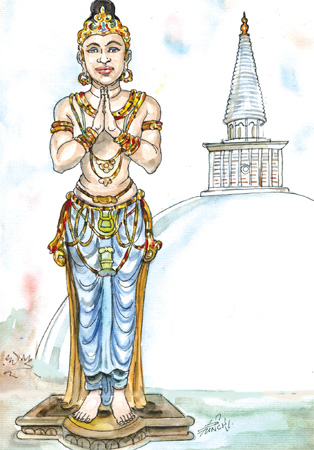The saga of King Dutugemunu
by Husna Inayathullah
Developing agriculture and filling the stores, strengthening the army
and turning out new weapons, Dutugemunu The Great got ready for battle.
Dutugemunu also known as Duttagamini or "fearless king" was a
Sinhalese king of Sri Lanka. He ruled from 161 BC to 137 BC. He is well
known for defeating and overthrowing Elara. Elara was the Tamil prince
from the Chola Kingdom. He invaded the Kingdom of Rajarata in 205 BC.

Dutugemunu expanded and beautified the city of Anuradhapura. He
projected the power of his native Rajarata region across the island.
Dutugemunu's story is found in myth and legend due to his
significance as one of the potent symbol's of Sinhalese military power.
According to historical chronicles King Dutugemunu descended from the
ancient royal family of Rajarata through Devanampiyatissa's brother
Mahanaga. Dutugemunu's father was King Kawantissa, the ruler of the
Rohana Kingdom. His mother was Vihara Maha Devi, daughter of Tissa, king
of Kalyani. The Mahavamsa describes how as a youth he mocked his father
for refusing to wage war against Elara.
Throne
Elara was the sole king of Anuradhapura who usurped the throne by
killing the native kings. Dutugemunu made his father furious by sending
him a piece of women's jewellery symbolising that if his father was a
man he would not have refused to wage war.
The resulting fury of the king caused many of his friends to flee to
Malaya region and the prince himself was dubbed Dutthagamani
(disobedient.) By 16 Dutugemunu was 'vigorous, renowned, intelligent and
a hero in majesty and might.' Determined to expel the invading king of
Rajarata, he raised an army from around Rohana and declared his
intention to regain the north to his father. The king forbade this
stating that 'the land on this side of the river is enough.' It resulted
in an exchange of words between father and son. Gamani's friends fled to
Malaya and he himself was incarcerated in a royal prison. Kavantissa is
known as a brilliant strategist who recognised early that he needed to
make his kingdom powerful before waging a war against the invaders. He
assembled armies and made his kingdom self-sufficient in "rice and betel
leaf." This meant that the people had a lot of agricultural surplus.
Giants
The legendary ten "great giants," men who had great strength were
recruited to the army. Kavantissa repeatedly made Dutugemunu and Tissa
swear that they would never fight one another and that they would always
respect and listen to the advice of Bhikkhus. He also made the ten
giants swear never to pick sides in a war between the brothers.
Upon Kavantissa's death, Dutugemunu found himself having to defend
his crown against his younger brother Tissa, who had seized possession
of not only the elephant Kandula, but also queen
Viharamahadevi as well. The war between the two began with the defeat
for Dutugemunu at Culanganiyapitthi, where many thousands of the king
Dutugemunu's men perished.
Battle
Dutugemunu was forced to flee back to Mahagama where he raised
another army and engaged Tissa in yet another battle in the vicinity of
the city. Legend has it that as Tissa, fought his brother riding the
royal elephant "Kandula," Dutugemunu rode a mare. Dutugemunu at one
point made the mare jump over the elephant causing the elephant to
recognise its master and attempt to kill Tissa who hastily dismounted.
Dutugemunu was victorious and Tissa was smuggled off the battlefield
disguised as the corpse of a Bhikkhu.
It is said that Dutugemunu recognised the ploy and called out to his
brother "Are you not ashamed to be carried on the back of these Bhikkhus?"
Sometime afterwards, however, Dutugemunu and
Tissa were reconciled through the efforts of Viharamahadevi and the
Bhikkhus, and Tissa became one of the king's foremost Generals.
Having secured his position Dutugemunu then planned his operations to
regain the North, which included not only Rajarata but also numerous
smaller semi-independent kingdoms. The king's army consisted of
'chariots, troops and beasts for riders', soldiers and a number of war
elephants, as well as a number of Bhikkhus and a relic placed in his
spear for luck and blessings.
In addition, he was accompanied by the famed ten giant warriors who
had been recruited from all over the island by his father Kavantissa.
The campaign reached a climax at the eastern gate of Anuradhapura, where
Dutugemunu, riding Kandula, finally confronted the aged king Elara, on
his own elephant Mahäpabbata, and slew him with a dart. This encounter
is one of the most famous in Sri Lankan history.
Dutugemunu's victory at Anuradhapura put him in the unprecedented
position of ruling nearly the entire island. Despite this his position
was far from problem-free. Elara, despite being an invading Tamil from
the Chola empire of south India, was renowned as having been a just and
righteous ruler. Dutugemunu went out of his way to ensure that the
memory of the old king was revered as he cremated Elara's body and built
a tomb for his ashes and made rules for travellers to pay their respects
to his tomb.
Furthermore, looking back upon his glorious victory, great though it
was, he knew no joy, remembering that thereby was wrought the
destruction of thousands of enemies and his soldiers.
This is attested by the sheer number of religious foundations
attributed to him by the chronicles which include magnificent stupas,
monasteries and shrines. |

